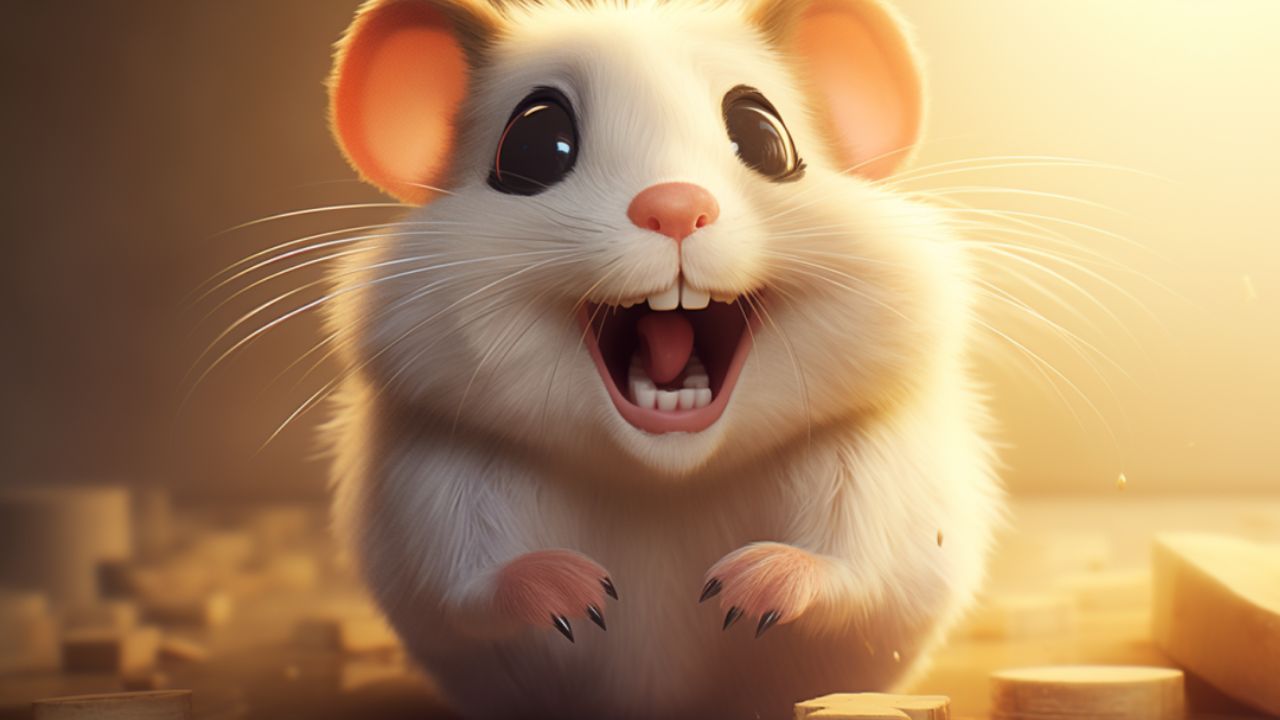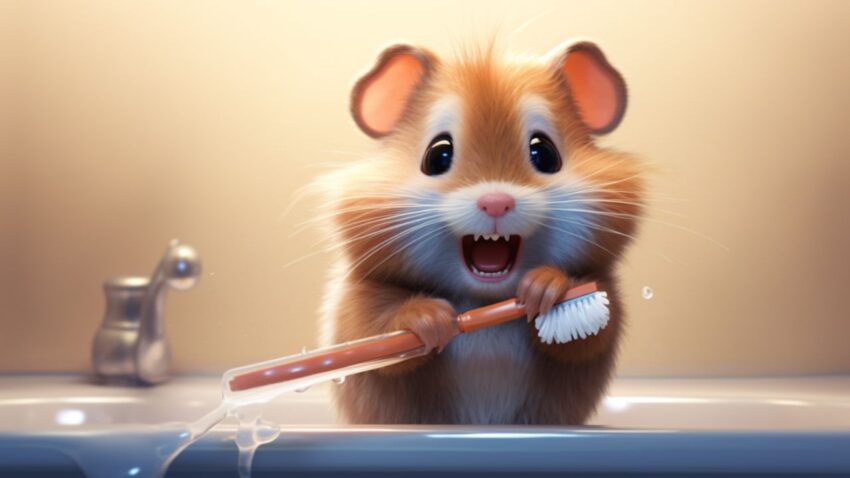Hamsters, often considered pocket-sized wonders, hold a unique spot in the hearts of pet lovers globally. Their charismatic presence and playful nature endear them to many, but beneath their delightful exterior lies a crucial aspect that requires every pet owner’s vigilant attention: their dental health. Delving into the world of hamster dental care reveals intricacies and nuances that are pivotal to their overall well-being.
The Importance of Dental Vigilance in Hamsters
Every nibble, every munch, and every bite a hamster takes is a testament to the essential role their teeth play in their daily life. These compact creatures, despite their small stature, have dental needs as significant as larger animals. The structure and functionality of their teeth aren’t just for aesthetic purposes or simple dietary needs. They play a pivotal role in various facets of their existence, from communication with fellow hamsters to processing complex food items.
Moreover, hamsters have evolved over the years with a dental structure that continually grows, adapting to the wild environments they originated from. In nature, their diet primarily consisted of abrasive foods that naturally kept their teeth filed down. In domestic settings, however, the lack of such natural abrasives can pose challenges. Hence, the continuous growth of their teeth, if unchecked, can lead to several health implications.
Overlooking their dental health can be detrimental, affecting their nutritional intake, and by extension, their growth, energy levels, and even lifespan. The essence of hamster dental care is not merely about addressing present concerns but being proactive in preventing potential ones.
Common Dental Concerns in Hamsters
A dive into the realm of hamster dental care reveals a myriad of potential concerns. From overgrown incisors that hinder their feeding ability to issues like malocclusion, where teeth don’t align correctly, the dental challenges are varied. Periodontal diseases, abscesses, and even dental trauma due to accidents or fights with fellow hamsters are not uncommon.
Understanding the signs of these problems is crucial. For instance, a hamster dropping food often, losing weight, or displaying facial swellings could be indicative of dental distress. Another telltale sign is the presence of wetness around their mouth, commonly referred to as “slobbers,” which can result from the pain and discomfort of dental issues.
Educating oneself about these common dental problems and their symptoms is foundational in a hamster owner’s journey to provide the best care for their furry friend. Only through awareness can timely intervention and effective prevention be achieved.
The Anatomy of Hamster Teeth

Dental anatomy, much like the intricate wonders of the cosmos, often goes unnoticed but is packed with captivating details. This is especially true for our furry companions, the hamsters. Delving deep into the structure and peculiarities of hamster teeth offers insights not only into their evolutionary journey but also into the unique challenges they face and the care they require.
Unraveling the Structure of Hamster Dentition
At first glance, a hamster’s mouth may seem simple, but behind those whiskered lips lies a sophisticated dental structure. Hamsters possess two pairs of incisors – one at the top and one at the bottom – which are prominent and easy to spot. These incisors are sharp and chisel-shaped, designed primarily for gnawing and cutting food. Behind these, in the back of the mouth, lie the molars, essential for grinding down harder foods into digestible bits.
The incisors, particularly, have an enamel coating on the front which is typically yellowish-orange in color, contrary to the popular perception of “healthy white teeth”. This coloring is natural and is a testament to the teeth’s strength. The molars, on the other hand, are not always visible without a proper examination and are crucial for a hamster’s diet of grains, seeds, and harder food items.
The Phenomenon of Continuous Growth
One of the most fascinating aspects of hamster dental anatomy is the continuous growth of their teeth, especially the incisors. Unlike humans, whose teeth stop growing after a certain age, a hamster’s teeth grow throughout its life. This perpetual growth is an evolutionary adaptation, as their ancestors in the wild consumed abrasive foods, like seeds, nuts, and plant stems, which naturally wore down their teeth. If their teeth didn’t grow continuously, they’d be at risk of having no teeth left due to the consistent wear and tear.
However, in domestic settings, this evolutionary marvel can become a concern. Without the appropriate diet to grind their teeth down naturally, hamsters face the risk of overgrown teeth. Overgrowth can lead to the teeth becoming misaligned (malocclusion), which can hinder their ability to eat, lead to infections, and even injuries inside the mouth.
Recognizing the implications of this continuous growth is vital. It underscores the importance of regular dental checks, providing a suitable diet and chew toys, and understanding that a hamster’s dental needs are an ongoing concern throughout their lifetime.
Signs of Dental Problems

Just as humans manifest signs of dental discomfort or ailments, hamsters too show tell-tale indicators when facing dental challenges. With their tiny mouths and non-vocal nature, it becomes crucial for hamster owners, or as I like to call them, ham-parents, to be astute observers. Recognizing these signs early can be a lifesaver, quite literally, as dental problems, if unaddressed, can escalate into life-threatening situations for these petite beings. From observable physical symptoms to subtle behavioral alterations, let’s explore the signals that hint at potential dental woes.
Physical Symptoms: The Visible Distress
The mouth and surrounding area can offer a plethora of insights into a hamster’s dental health. Here are some conspicuous signs:
- Overgrown or misaligned teeth: Regularly checking the length and alignment of your hamster’s incisors can help catch overgrowth before it becomes problematic. Ideally, the top and bottom incisors should meet, allowing the hamster to gnaw effectively.
- Drooling or wetness around the mouth: While a little moisture is natural, excessive drooling can indicate dental discomfort or injury.
- Swelling around the face or jaws: Any swelling or lump could be a sign of an abscess, infection, or injury due to misaligned teeth.
- Weight loss or reduced appetite: If your hamster is not eating its usual amount or is losing weight, dental issues might be the underlying cause, as pain can deter them from eating.
- Blood or discharge: Blood on their food, toys, or bedding, or any unusual discharge from the mouth, is a clear sign of potential injury or infection.
Behavioral Changes: The Subtle Hints
While physical symptoms are more direct, hamsters also display behavioral changes when they face dental discomfort. These changes might be more challenging to spot but are equally significant:
- Reduced interest in hard foods: If your hamster shies away from its usual hard treats or food pellets, it might be experiencing dental pain.
- Hoarding soft foods: A hamster gathering more soft foods than usual might be an indication that they’re avoiding the discomfort of chewing harder foods.
- Frequent pawing at the mouth: While grooming is a regular activity, if your hamster frequently paws at its mouth or seems distressed while doing so, it could be a sign of dental discomfort.
- Less activity or hiding: A change in your hamster’s usual routine, like decreased activity levels, avoiding their wheel, or hiding more frequently, can be indicative of not just dental, but any pain or distress.
Understanding and recognizing these signs is half the battle. Once spotted, it’s vital to seek veterinary advice and intervention. Early detection and timely care can prevent minor dental issues from ballooning into major health concerns.
Common Dental Issues in Hamsters

Hamsters, with their ever-growing teeth and unique oral anatomy, are predisposed to certain dental issues that can severely affect their health and quality of life. Given the crucial role that dental health plays in their overall well-being, understanding common dental concerns is essential for every responsible hamster owner. By staying informed, one can ensure timely interventions and provide the best possible care for these little companions. In this section, we will delve into some prevalent dental problems hamsters face and the implications of each.
Overgrown Teeth: A Constant Challenge
Hamster teeth never stop growing, a phenomenon that ensures their teeth remain sharp and effective for their herbivorous diet. However, this continuous growth can sometimes lead to problems, especially if the hamster isn’t provided with adequate opportunities to wear down its teeth naturally.
- Causes: A lack of suitable gnawing materials, an improper diet, or genetic factors can contribute to overgrown teeth.
- Implications: Overly long teeth can pierce the hamster’s upper or lower jaws, leading to immense pain and difficulties in eating. In extreme cases, these teeth can curve into the hamster’s mouth or neck, leading to life-threatening complications.
- Prevention & Treatment: Regularly providing hard gnawing materials, like wooden chew toys or untreated branches, can help. Monitoring tooth length and seeking timely vet care for trimming is essential.
Malocclusion: When Teeth Don’t Align
Malocclusion refers to the misalignment of a hamster’s teeth, particularly the incisors. When the upper and lower teeth don’t meet properly, they can’t wear each other down effectively, leading to potential overgrowth and associated issues.
- Causes: Genetic predispositions, injuries to the jaw or mouth, or premature loss of a tooth can lead to malocclusion.
- Implications: Misaligned teeth can result in overgrowth, facial swelling, drooling, and difficulty in eating.
- Prevention & Treatment: Regular dental check-ups can help in early detection. In many cases, veterinarians can trim or file the teeth to correct the alignment, but ongoing care might be necessary.
Dental Abscesses: Pockets of Pain
A dental abscess is a pocket of pus that forms due to a bacterial infection in a hamster’s mouth. These abscesses usually form around the root of a tooth and can be quite painful for the little creature.
- Causes: Dental abscesses can stem from injuries to the mouth, advanced dental disease, or the entry of bacteria into the oral cavity.
- Implications: Abscesses can lead to facial swelling, reduced appetite, drooling, and a noticeable lump in the affected area. If untreated, the infection can spread, leading to more severe health issues.
- Prevention & Treatment: Maintaining good oral hygiene and providing a clean living environment can reduce the risk of abscesses. If an abscess is suspected, immediate veterinary attention is vital. Treatment usually involves draining the abscess and administering antibiotics.
While these issues can sound alarming, being proactive, observant, and ensuring regular health check-ups can keep most dental problems at bay, ensuring your furry friend remains happy and healthy.
Promoting Dental Health: Best Practices

Just as humans prioritize dental hygiene to maintain overall health, hamster owners must proactively care for their pet’s dental well-being. Hamster teeth, with their ceaseless growth, require consistent monitoring and particular care measures. With issues ranging from overgrown teeth to dental abscesses, prevention is always better than cure. Below, we’ll explore the best practices to promote optimal dental health in hamsters, ensuring they lead comfortable and pain-free lives.
Proper Nutrition: The Foundation of Strong Teeth
The saying, “You are what you eat,” holds as true for hamsters as it does for us. Their diet plays a pivotal role in both tooth growth and wear.
- Seeds and Grains: While seeds and grains form an essential part of a hamster’s diet, they shouldn’t be the only component. Relying solely on them can lead to insufficient wear on their teeth.
- Fresh Vegetables: Introducing a variety of fresh vegetables like carrots, broccoli, and leafy greens can offer the necessary nutrients and help wear down their teeth naturally.
- Pelleted Diets: These are specially formulated to provide balanced nutrition and promote the right amount of chewing. Pellets can prevent selective eating, ensuring they get all the essential nutrients.
- Calcium Sources: A good calcium source, such as cuttlebone, can strengthen teeth and provide a hard surface for gnawing.
Chew Toys and Materials: Natural Wear and Tear
Providing ample opportunities for hamsters to grind down their teeth is vital in preventing overgrowth and other dental complications.
- Wooden Toys: Untreated wooden blocks or toys can be excellent for hamsters to gnaw on. Ensure the wood is safe and hasn’t been treated with any harmful chemicals.
- Natural Branches: Apple, pear, or hazelnut tree branches are great for chewing. They not only help wear down teeth but also provide essential nutrients.
- Mineral Chews: These can offer a dual benefit: providing essential minerals and a hard surface to gnaw on.
- Avoid Plastic: Plastic toys can break into sharp pieces, posing a choking hazard and potential injury risk.
Regular Check-ups: Prevention and Peace of Mind
Routine health evaluations are the cornerstone of any preventive care regimen.
- Home Monitoring: Make it a habit to observe your hamster’s eating behaviors. If they’re struggling or showing reduced interest in food, it may indicate a dental issue.
- Professional Examinations: A vet specializing in small animals can provide regular dental check-ups, ensuring early detection of potential problems. They can assess tooth length, alignment, and signs of disease.
- What to Expect: During a check-up, the vet might gently open the hamster’s mouth using a small instrument. They’ll visually inspect for any abnormalities, excessive growth, or inflammation. If there are issues, they might suggest treatments like tooth trimming or other medical interventions.
Remember, the road to a hamster’s optimal dental health is paved with consistent care, a balanced diet, and regular check-ups. These practices not only ensure their comfort but also significantly contribute to their overall health and longevity.
The Role of Professional Veterinary Care

While regular home care is paramount for a hamster’s dental health, there are instances when professional intervention becomes crucial. Hamsters, despite their small size, have complex dental structures that can develop issues beyond a pet owner’s capacity to address. Understanding when to consult a vet and the significance of professional dental evaluations can be the dividing line between early problem detection and prolonged suffering for these little creatures.
When to Consult a Vet: Identifying the Red Flags
Pet owners are usually the first line of defense when it comes to detecting abnormalities in their hamsters. While regular check-ups are essential, knowing when to seek immediate veterinary care can be life-saving.
- Refusal to Eat: One of the most telling signs of dental discomfort is when a hamster consistently avoids food, especially their favorite treats.
- Drooling or Wetness Around the Mouth: Excessive drooling can indicate pain or difficulty in chewing.
- Swelling Around the Face or Jaw: This could point to dental abscesses or other infections.
- Bad Breath: A sudden onset of foul-smelling breath can be a sign of oral infections.
- Weight Loss: If not eating due to dental issues, a hamster may rapidly lose weight, which requires immediate attention.
- Visible Overgrowth of Teeth: If the teeth look visibly long or misaligned, it’s time for a dental check.
The Importance of Professional Dental Examinations: Beyond the Obvious
A professional’s perspective is irreplaceable. Vets possess the knowledge and tools to delve deeper into issues that might not be visible to an untrained eye.
- Thorough Evaluation: A vet can conduct a comprehensive examination, including X-rays if necessary, to understand the root cause of a dental problem.
- Safe Tooth Trimming: Overgrown teeth might require trimming. Professionals can do this safely without causing discomfort or injury to the hamster.
- Early Detection: Regular dental check-ups by a vet can detect issues before they escalate, ensuring timely interventions and reducing the risk of complicated procedures.
- Guidance on Home Care: Vets can provide valuable insights into maintaining dental health at home, recommending specific products or dietary changes tailored to your hamster’s needs.
In conclusion, while daily care and monitoring play a significant role in a hamster’s dental health, professional veterinary care bridges the gap between general maintenance and specialized treatment. Balancing the two ensures that hamsters lead a comfortable, pain-free life with a set of healthy teeth to show off.
Prioritizing Tiny Teeth for Overall Well-being

It’s easy to be captivated by the antics and charm of our petite pets, often losing ourselves in their playful nibbles and endearing nature. However, as the guardians of these small beings, understanding and prioritizing their dental health is a non-negotiable aspect of our responsibility. Their tiny teeth, although often overlooked, play a pivotal role in their overall health and well-being.
The Centrality of Dental Care
The significance of dental health in hamsters goes beyond mere aesthetics or the functionality of chewing. Oral problems can cascade into a series of complications, affecting their nutrition intake, causing pain, or even leading to systemic infections. Overgrown teeth, for instance, aren’t just an inconvenience but can turn into life-threatening conditions if not promptly addressed. Thus, maintaining their dental health isn’t a mere act of care but a cornerstone of ensuring their overall health and longevity.
Taking Proactive Steps: The Path to Longevity and Joy
As we’ve navigated through the intricacies of “Hamster Dental Care,” the resounding theme is the importance of proactive measures. Whether it’s providing the right nutrition, offering chew toys, or ensuring regular professional check-ups, being a step ahead can make all the difference.
Hamsters, with their limited lifespan, bring a burst of joy into our lives for a short while. Ensuring that this time is filled with comfort, vitality, and health for them is the least we can do in return. By focusing on their dental care, we not only enhance their quality of life but also ensure that our time with them is marked by happiness and devoid of preventable health crises.
So, as we conclude this exploration into the dental realms of our hamster companions, let’s pledge to make dental care a routine, not an afterthought. Let’s commit to being vigilant, informed, and proactive, ensuring that our furry friends lead lives that are as radiant as their smiles.




